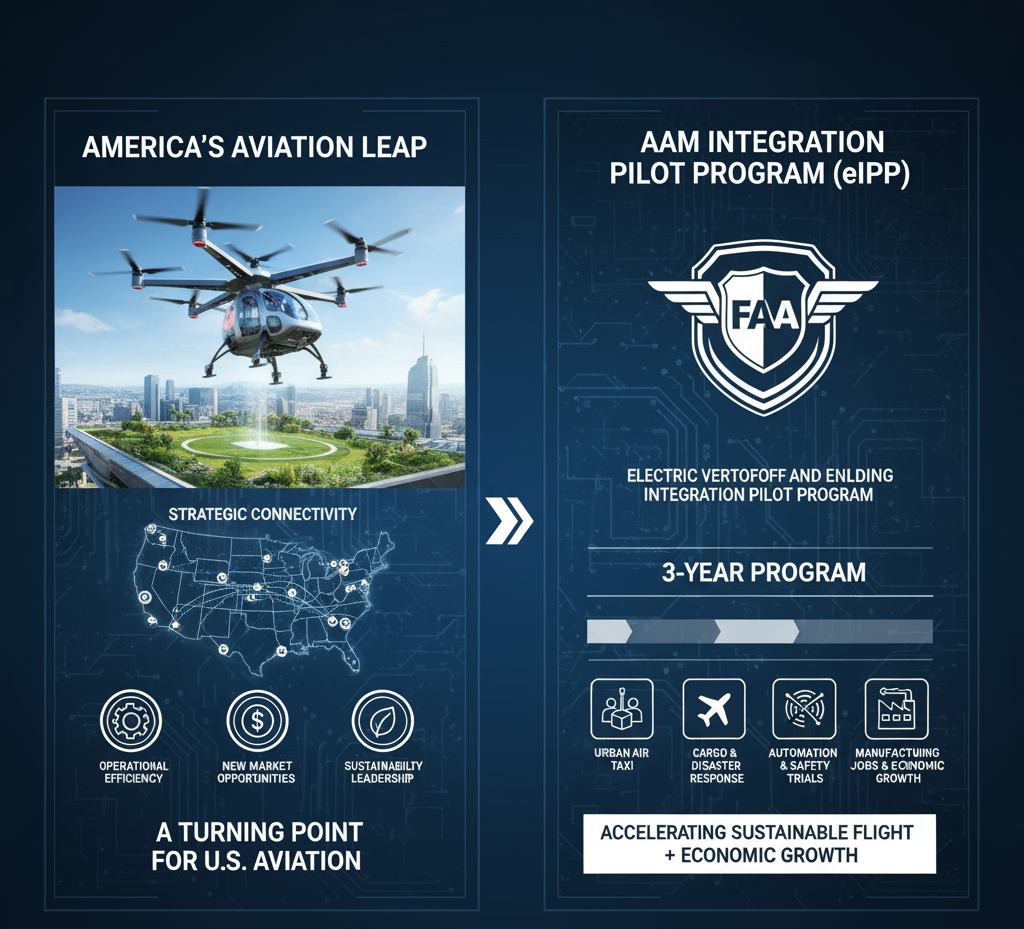
FAA Launches eVTOL Integration Pilot Program: A New Era for Advanced Air Mobility
1. The Announcement: A Turning Point for U.S. Aviation
In a move that could redefine how people and goods move across the skies, the U.S. Department of Transportation (DOT) has announced a major step toward integrating Advanced Air Mobility (AAM) into everyday life.
U.S. Transportation Secretary Sean P. Duffy unveiled the Electric Vertical Takeoff and Landing Integration Pilot Program (eIPP), a groundbreaking initiative led by the Federal Aviation Administration (FAA).
The program’s goal is simple yet ambitious: to accelerate the safe deployment of eVTOL aircraft and AAM systems across the United States.
“The next great technological revolution in aviation is here,” said Secretary Duffy.
“The United States will lead the way, and doing so will cement America’s status as a global leader in transportation innovation.”
2. What This Means for the Future of Mobility
For decades, innovation in aviation has meant bigger jets, faster travel, and more efficient navigation. But the rise of electric vertical takeoff and landing (eVTOL) aircraft, commonly known as air taxis, signals a shift toward something truly transformative.
The FAA’s eIPP program will explore how these next-generation aircraft can safely operate in real-world environments. Through public-private partnerships, the initiative will allow state and local governments to collaborate with private aviation companies to develop frameworks for safe and scalable AAM operations nationwide.
“By safely testing these futuristic air taxis and other AAM vehicles, we can fundamentally improve how the traveling public and products move,” Duffy added.
“That means more high-paying manufacturing jobs and new economic opportunities for American communities.”
3. Why Executives Should Pay Attention
For business leaders across transportation, logistics, energy, and manufacturing, Advanced Air Mobility is not just a buzzword. It represents a massive shift in infrastructure, supply chain optimization, and workforce evolution.
Key Takeaways for Executives
Strategic Connectivity:
eVTOL aircraft could connect remote or rural regions to major cities, unlocking new business hubs and logistics routes.
Operational Efficiency:
AAM vehicles can reduce road congestion and optimize last-mile delivery, medical transport, and time-sensitive logistics.
New Market Opportunities:
From aerospace components to battery systems and AI flight control software, entirely new value chains are emerging.
Sustainability Leadership:
Electric propulsion technologies support ESG commitments and align with global carbon reduction goals.
For CEOs and investors, AAM is the next competitive frontier, blending innovation, sustainability, and economic expansion.
4. Inside the eIPP: Testing the Skies of Tomorrow
The FAA confirmed that the Electric Vertical Takeoff and Landing Integration Pilot Program (eIPP) will run for three years following its first operational project. The program includes at least five pilot missions, each testing a different real-world application:
- Short-range urban air taxi operations
- Longer-range fixed-wing eVTOL flights
- Cargo and logistics transport, including offshore energy support
- Medical and disaster response applications
- Automation and safety system trials
Each participant will collaborate with a U.S.-based private partner, using piloted, optionally piloted, or fully unmanned aircraft weighing over 1,320 lbs and capable of carrying passengers or payloads.
FAA Administrator Bryan Bedford noted, “This pilot program gives us another opportunity to advance the Administration’s plan to accelerate safe eVTOL and advanced air mobility operations across the United States.”
5. A Call to Innovators and Industry Partners
The FAA is inviting applications from state, local, tribal, and territorial governments in partnership with private companies to participate in the eIPP. The objective is to prove real-world viability for AAM technologies while maintaining strict safety standards within the National Airspace System.
In practical terms, this is an unprecedented opportunity for innovators and industry leaders to shape the policies, safety frameworks, and business models that will define the future of flight.
6. The Big Picture: Advanced Air Mobility as a Growth Engine
The eIPP is more than a technology experiment; it is a national economic initiative. As new AAM ecosystems emerge, they will bring manufacturing jobs, investment capital, and supply chain opportunities across the country.For American leadership, this represents a chance to reclaim the frontier of flight, just as it did in the early days of commercial aviation.
For executives, investors, and policymakers, this is a strategic invitation to participate in shaping the future.
The post America’s Next Aviation Leap: The FAA Launches Pilot Program appeared first on eaviationxchange.com.




